The FAA has known the importance of Angle of Attack instrumentation for decades. This was published by the FAA in the 1964 Flight Instructor's Handbook...
Note the use of "Unfortunately"and "not YET available"
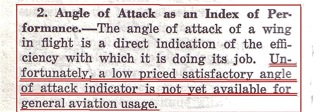
Forty seven years later....in early 2011, an Instrument-rated Commercial Pilot was studying for her Flight Instructor rating. She writes us: "I checked all my FAA Flight Instructor books (Aviation Instructor's Handbook; Airplane Flying Handbook, the Pilot's Handbook of Aeronautical Knowledge), and also Bill Kerschner's classic book: The Flight Instructor's Manual." She found no mention of how she should teach with, or fly using, an AoA indicator.
"The FAA books (all the latest versions) were totally silent on the subject of AoA instrumentation, yet Kerschner's superb book (1975 edition, p.83) does contain this one sentence:
'Since the average training airplane at present does not have an angle of attack indicator, the airspeed indicator is the instrument that sometimes warns of an impending stall.'
"SOMETIMES" is it? In Year 2011? Modern technology makes that: "ALWAYS"
"It seems as if the FAA once thought an AoA indicator would be an instrument they'd welcome on light airplanes; the FAA appears to have abandoned hope over the years. Personally, I think that being able to teach my students with an AoA in the panel is a great idea and I'm glad to see you bringing it back....
"I can easily recall the questions I had in my own training -- questions about speed, banks, G-loaded wings and AoA, etc., -- when doing stalls or coming in for landings. Short field landings especially concerned me because of their slower speeds. Not every instructor seemed capable of explaining all the variables involved and some confused me more than others. It's also easy to see that not every explanation gets through to every student. With such a vital concept as Angle of Attack, and its relationship to safe flight and avoiding stalls, and thereby preventing tragedies, it seems a no-brainer that something somewhere should exist to show -- in real time -- what the airplane is doing. A picture is worth a thousand words. In this case, the AoA indicator is seen in a glance and understood in an instant with no need for wordy explanations that might miss the mark".
Let's review Delta Captain Jack Stovall's comments, again. Recall that he spent an career as an Air  Force T38 Instructor Pilot and ended up as a Chief Instructor of other Instructor Pilots. With thousands of hours looking at an AoA, he notes: Force T38 Instructor Pilot and ended up as a Chief Instructor of other Instructor Pilots. With thousands of hours looking at an AoA, he notes:
"Almost every certified airplane in the United States has an AoA indicator already. It's called the stall warning and it works just fine. The problem is that it's just like an inconsiderate driver who cuts you off in traffic JUST AS the idiot signals a lane change.
You get the warning ... but it's almost too late to do anything about it."
NOTE: FAA Guidance for Stall Warning has NEVER said it has to be a "too-late warning" or a "poor warning". There is NOTHING in the FAA guidance that prevents a BETTER WARNING being made available if and when new technology evolves. Wouldn't an EARLY warning -- a warning that comes in time -- be a lot better than one that comes too late?
, 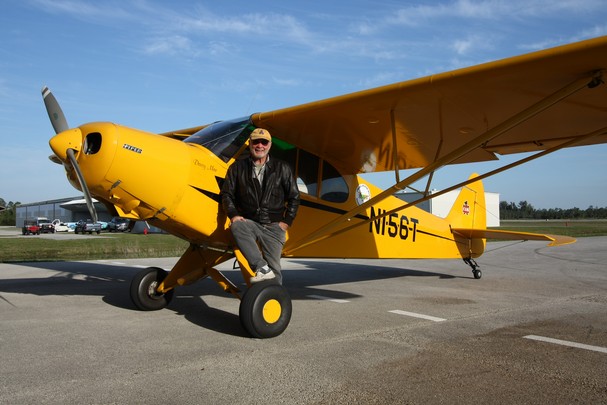 Jim teaches pilots tail wheel skills in this Piper Super Cub. Jim teaches pilots tail wheel skills in this Piper Super Cub.
He also flys a Super Decathlon and a Pitts to give instruction in aerobatic skills. Regularly featured on the weekly programs of General Aviation TV On-Line, Jim's at the head of the line to install an AoA indicator to teach with.
He strongly supports AoA instrumentation. He writes: "I would dearly love to have something like this in widespread use, as long as pilots were trained to use it.
Tom ought to know; he’s a Master CFI with a Masters Degree in Aviation Safety, and is 2008 FAA Central Region CFI of the Year; he’s a FAA Safety Team Lead Representative, too.
. He's installing an AoA in his Citabria. Johnny has an airplane for any kind of sport or aerobatic flying or spin training: a Cub, a Citabria or a Pitt which he uses for Advanced and Unlimited Aerobatics, Advanced Spins, and for Pitts transition training if you want to learn the secrets of any S2 or S1 series Pitts airplane. Johnny, says: "Having an AoA indicator would make it so much simpler to teach why Angle of Attack matters so much.
"The AlphaSystem AoA is really a 'Stall Margin Indicator' and not a true AoA, but it will serve the purpose, just fine." [Johnny is EXACTLY RIGHT!].
"I would like to see the people who fly airplanes demand AoA and the FAA get up to speed and endorse the use of simple AoA early warning systems...to try to prevent the inadvertent Stall /Spin."
Master CFI Rich Stowell, FAA 2006 National Flight Instructor of the Year, has written a great book entitled, "" Stowell says that "the Wright Brothers gave us the gift of powered flight more than a century ago. But the gift has its limitations: potentially dangerous stalls and spins lurk beyond the critical angle of attack." His thoughtful book combines 100 years of light airplane research with practical knowledge about the stall/spin environment into one of the most comprehensive guides to Stall/Spin Awareness available.
The recently delivered the second of eight planned “Seminar-in-a-Box” (SIB) products for use by the FAA Safety Team (FAASTeam). Entitled, "Maneuvering at Low Altitude: SPINS", the SIB was created by Rich Stowell. He's a noted expert; he has logged nearly 32,000 spins with students.
FAA AFS-800 has identified stall/spins as a causal factor in two of its top ten fatal accident classifications. According to Stowell, “Improved stall/spin awareness and its associated safety dividend depend on the training provided by instructors, so I was delighted to participate in a project for SAFE and the FAASTeam aimed at CFIs and DPEs.”
Dan Rogers, a CFI in Gordonsville, VA teaches Stall/Spin training "An AoA indicator removes virtually all AoA guesswork... If I had my druthers, I’d like to see an AoA indicator and an inclinometer in all aircraft. What a great combo." and he .
As does the FAA in its excellent Advisory Circular AC61-67C:
"Stall and Spin Awareness Training"
Read this from 1994: by Bruce Landsberg, Director of the AOPA Air Safety Institute. Bruce has, for decades, been preaching that we need Alpha-sensing systems, an he has long ago been proved right.
Here's a really good AOPA Air Safety Foundation article
STALL/SPIN: ENTRY POINT FOR CRASH AND BURN? A brief clip:
Student pilots and ATPs are the least likely to stall/spin. Student pilots are, by far, the least likely to suffer stall/spin accidents, as a proportion of in the pilot population. Pilots holding FAA Airline Transport Pilot (ATP) certificates are also less likely to stall/spin.
That leaves pilots with FAA private and commercial pilot certificates in the "most likely to suffer fatal stall/spin accidents" category. In fact, commercial pilot certificate holders are by far most likely to show up in the stall/spin accident statistics, again based on the proportion of their representation in the pilot population.
An instructor on board is no guarantee. In reviewing 44 fatal stall/spin accidents from 1991 - 2000 and classified as instructional, ASF found that a shocking 91%(40) of them occurred during dual instruction, with only 9% (4) solo training flights. Of the fatal instructional accidents, 64.4% of them occurred during maneuvering, and 17.8% of them occurred during takeoff.
We recent came across this which is a chapter-link of . A detailed "internet book," it's worth serious study. Written by John Denker, he is a Commercial Pilot, Flight Instructor, Ground Instructor and a FAA Aviation Safety Counselor.
Brad Haslett, FedEx 777 Captain, FedEx MD11 Captain and MD11 simulator instructor. Beech Bonanza and Baron owner:
"Why we don't have an AoA on all airplanes is beyond my comprehension. We flew nothing but AoA on the Citation and it works great. It is simple technology and is 'off the shelf'. ...The airspeed indicator is better than nothing, but this is the 21st Century, for God's sake.
"High time and experience is no savior for directing your attention to the wrong information, or not having information, or ignoring the information you do have. Obviously, not every RV8, Bonanza, or King Air can carry all the 'idiot prevention' technology that my Boeing 777 can, but why don't we have a cheap and effective AoA for GA aircraft? The 'stuff' required to build an AoA is already there. What's in the way?
More from Thomas P. Turner,
In his Dec 2010 to get maximum performance and avoid mishaps: "I benefited from the generosity of reader Charles Lloyd, a NetJets captain. He flew to Wichita in his Cessna 182J to give me some left-seat experience using the Alpha Systems angle of attack indicator. I quickly found using the AoA to be easier and vastly superior to flying by reference to the airspeed indicator—my lack of recent experience in Cessna 182s made maximum performance even easier for me using AoA. about my AoA experience, linking to some of Charles’ writings on the topic, exploring different displays and options, and maybe making you an AoA enthusiast too...in upcoming issues of ."
Charles Lloyd, is a retired Cessna Citation Marketing Executive and NetJets captain......his personal Cessna 182J is Legacy AoA-equipped. "I started with a vertical 16 light bar installation on the glareshield and upgraded it to the Legacy AoA display, which I like a lot better.
"STOL operatio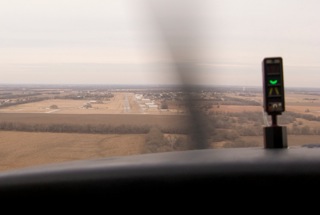 n is not the major reason for installing AoA. Here are questions to ask yourself: n is not the major reason for installing AoA. Here are questions to ask yourself:
• What is the stall speed difference between flaps up and full flap configuration? Some heavy singles have a 20 knot variation is stall speed depending on flap configuration and landing weight.
• Do you ever forget to set flaps for takeoff or landing?
• Do you ever bank more than 20 degrees?
• Do you want more consistent landings?
"These are the reasons I installed an Alpha AoA system in my Cessna 182 after flying Citations with AoA installed during my time at Cessna and NetJets. The AoA system is there to prevent a killer steep turn-to-final accident and provide consistent landing touchdown points and roll outs. Using AoA makes my landings more consistent plus I know how much lift the wing is generating instantly at any attitude and airspeed.
"I am a contributing editor for Cessna Flyer Magazine and am in the process of writing an article about my AoA installation."
Earle Thompson, flies his Legacy AoA-equipped B-55 Baron out of Dothan, AL. Colonel Thompson just retired as chief of the Air Force safety division at HQ in D.C. He flew the T-37 and T-38 in pilot training.
"The instrumentation will make general aviation folks safer if it catches on. The T-38 has an AoA, but the T37 did not. The new T-6 Texan is the replacement for the T-37 and it does have an AoA guage. The A-10 and the F-16 both had an AoA gauge in the aircraft and it was used to fly the approach and landing (and aero-brake in the F-16) all the time. Guys who did not use it properly always had hot brakes and long, sloppy landings."
Will Moore acted as one of our test pilots. He's a CFI, a former RJ airline pilot and a Pilatus crew member. He recently told me that... "Pilots of jet aircraft consider the AoA indicator an indispensable instrument, and it’s surprising that until now no AoA system has caught on for widespread use in general aviation. Thanks to Alpha Systems Inc., even light aircraft can now take advantage of the safety benefits of the AoA indicator. I’ve flown with the Alpha Systems unit installed in a King Air 90, a Citabria, and a Cessna 206. It works beautifully.
"I can also heartily recommend this instrument to owners of tube-and-fabric aircraft. Last month I gave dual instruction in a Citabria equipped with an Alpha Systems AoA indicator. Those of you who have spent time in the back of a tandem-seat taildragger know that the view of the instrument panel is almost completely blocked by the front-seat occupant. The airspeed indicator in the Citabria was hidden from my view, but since the AoA indicator was mounted on the glareshield, I had a clear view of it over my student’s shoulder. It’s not a primary instrument, but it sure helped to give me peace of mind during approach and landing.
"In fact, the AoA indicator was probably more useful than the airspeed indicator as we practiced short field landings on a nearby grass runway. The Citabria has no flaps, and therefore tends to float when carrying excessive airspeed on landing. With the Alpha Systems unit we were able to maintain a precise angle of attack with a comfortable stall margin, while at the same time minimize float and rollout distance.
"Given the low cost, ease of installation, and overall effectiveness of the Alpha Systems AoA indicator, I’m guessing that a lot more pilot owners will be installing this useful piece of equipment in their aircraft."
John Corradi. UAL 777 retired,  formerly a Navy P-3 Orion Captain, and manager of The Wright Experience (the Wright Flyer replica). formerly a Navy P-3 Orion Captain, and manager of The Wright Experience (the Wright Flyer replica).
There is a short PBS show with John and his pals at the ".
every week at the Flying Circus near Washington DC and he says...
“What a GREAT idea to promote AoA in light aircraft! After I got out of the Navy, I never could figure out why civilians didn't fly AoA.”
John Cutcher, Falcon 10 Captain, former Naval Aviator in the P-3 Orion:
"I enjoyed reading Al Aitken's Flight Test reports. Leave it to the pros (Marine air) to produce a quality product.
"As a Designated Pilot Examiner (BAL FSDO), I have a first-hand view of the lack of understanding/appreciation of AoA on the part of applicants for pilot certificates. When I discuss high/hot (Density Altitude) operations on the oral exam, better than 75% of the applicants are really weak. For example: most add additional IAS on approach 'due to the "thin air"...!' The concept of 1.3Vso (Vref) is neither taught nor understood.....
"If I ran a flight school, I'd certainly take up the offer of a free AoA system for training. What a great thing you're doing in that department."
Kent "Eagle" Ewing was Captain of the aircraft carrier USS America during Gulf One. A Naval Aviator, of course, Kent recently led the - run by the American Bonanza Society. "I was fortunate to fly with a customer at our 2012 Greensboro clinic who had the AlphaAoA installed on his Beech A36. The AoA indexer was installed just as in many Navy aircraft I have flown: above the glare shield right next to the left canopy bow... similar to the A4 Skyhawk. The system was calibrated perfectly, coordinated with the Beech stall warning detector and the airspeed scales. The AoA matched the buffet band as we approached the top of the CLmax Alpha curve ... and the color scheme of the indicator was just great.
"This young pilot said that for the price of the system...about $2,500... it was going to save his life someday. We conducted every imaginable stall scenario, including a full power accelerated stall (Sorry. I reverted to my Pax River test pilot techniques, I guess...) and the AoA system reacted quite well......I did like the system overall and best of all: I liked how precise it was in such a light airplane with good reactions from such a simple system!!
"I fly a dual AoA wind driven system on the Eclipse jet that is not quite as reactive ... it's adequate but not as good as the AlphaAoA. There is no AoA indicator in the Eclipse but it feeds the stick pusher system.
"... am still thinking how/when we can get this fantastic idea/system/program into the BPPP curriculum...."
+++++++++++++
Consider this, please: As you have been reading these "Voices", have you been noticing that it's the highly skilled aviators who are also the most enthusiastic advocates of AoA instrumentation?
WHO MAKES THESE DISPLAYS? The only one we have test flown is the which we discuss extensively on this site. The only one we have test flown is the which we discuss extensively on this site.
In 2016, the Alpha System AoA was approved as a "As an aeronautical engineer and former naval aviator, I learned early that an AOA system offers an optimum way to maintain a safe margin above stall,” said Rick Wheldon, vice president of Turbine Aircraft Services, which provides product support for the MU-2 series under contract to Mitsubishi Heavy Industries America.
The same man (Mark Korin) who owns AlphaSystems was also the original designer of quite similar system known as a a of the LRI installation and
I recently learned of which is 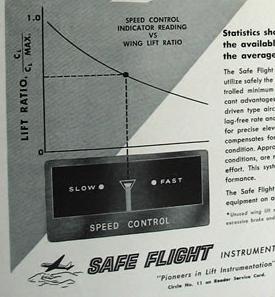 flying in a few certificated aircraft, but mostly in homebuilts. I have had a nice chat with the owner, who clearly knows his aerodynamics. A very nice man; we share the common goal of stopping the stall/spin crashes. I hope that someone will, soon and independently, flight test his device, much as we have the flying in a few certificated aircraft, but mostly in homebuilts. I have had a nice chat with the owner, who clearly knows his aerodynamics. A very nice man; we share the common goal of stopping the stall/spin crashes. I hope that someone will, soon and independently, flight test his device, much as we have the
For years, we have all used stall warning vanes made by the ...but they don't make the SC-100 any more. That's a real shame, as it worked great (I can't prove that with formal test flight data; I just flew it for ~2,000 hours in my Bonanza 36).
Safe Flight does make a Speed Control System 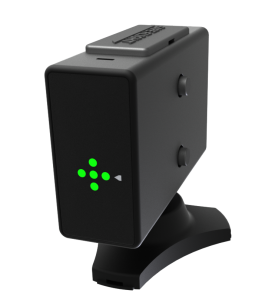 that's ; in 2009 Cirrus announced that "Safe Flight's Speed Control System is the most comprehensive Stall Warning System offered to the general aviation market...and ... provides limited range Angle-of-Attack as well as precise stall warning...". that's ; in 2009 Cirrus announced that "Safe Flight's Speed Control System is the most comprehensive Stall Warning System offered to the general aviation market...and ... provides limited range Angle-of-Attack as well as precise stall warning...".
UPDATE as of July 2015: FAA has now certified the SCc® Leading Edge Angle of Attack for a number of light aircraft! Further news: Beginning in 2016, Bravo to Textron/Cessna! and full credit is due to AlphaSystems for leading the way.
Dynon Avionics makes and has a nice discussion here.
In 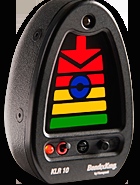 2013, display. Very nice! It's no great secret that BK was smart enough to use a sensor/display supplier who already had a flight-test-proven device and they repackaged that AlphaSystemsAoA with a few nice changes. We have not flight tested or even flown it, but we have high confidence that it would perform very similarly to the Alpha Systems AoAs that we have. 2013, display. Very nice! It's no great secret that BK was smart enough to use a sensor/display supplier who already had a flight-test-proven device and they repackaged that AlphaSystemsAoA with a few nice changes. We have not flight tested or even flown it, but we have high confidence that it would perform very similarly to the Alpha Systems AoAs that we have.
In early 2015 we learned of the CheckYourAngle CYA-100 made by Rip Quinby, the owner of General Technics. Like us, he want pilots to learn about alpha-sensing devices and he'd be happy to sell you his, but he's also happy if you install SOMEONES's AoA display.
Here's the simplest device we have heard of. Terrence O'Neill is a retired Naval Aviator. He still hand-crafts his "Bacon Saver" because, he tells us, "...the year after I was released from active duty as a Naval Aviator, in 1957, the Navy put its first AoAs on every carri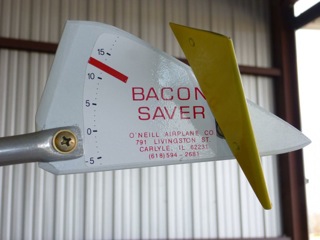 er-based airplane. What was the result? er-based airplane. What was the result?
The very next year these excellent, experienced Navy carrier-pilots' accident record for landing crashes was cut 50% -- FIFTY PERCENT!"
The Bacon Saver seems to be a simple mute vane that might be useful on very light aircraft. The Wright brothers used a very similar device on the Wright Flyer. We have NOT flight tested it. Cost is about $200 plus about $20 shipping in the US (in mid-summer 2014)
Contact the O'Neill Airplane Co.
791 Livingston St., Carlyle, IL 62231 Tel. 618 594 2681
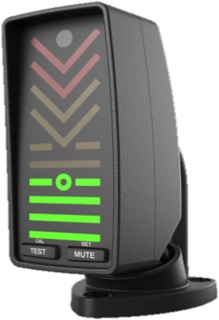
In mid-summer 2014, Garmin announced its GI 260 Angle of Attack Indicator option for the G3x displays. Isn't it nice to see the major manufacturers coming on board?
We have not seen or flown it, but
it will look like this >>>>
Here, read more published documents on Alpha displays
...and a few web-posts by experienced aviators
and here, more web-posts by pilots using AoA displays
Read what two greatly-experienced King Air pilots know; both grew from Civilian to Military and then back to civilian King Airs. Interesting perspectives.
Take a look at the accident summaries. Click here.
HUGELY IMPORTANT! ... RECENT NEWS! ... June 2015--in the , the FAA is making a big push to get AoA indicators installed in General Aviation aircraft.
In its extraordinarily helpful December 2011 FAA clarification letter, the FAA Small Aircraft Directorate explains that installation is a "minor alteration" on the vast majority of light general aviation aircraft.
Click here to begin again the series "Voices of those who know" |






